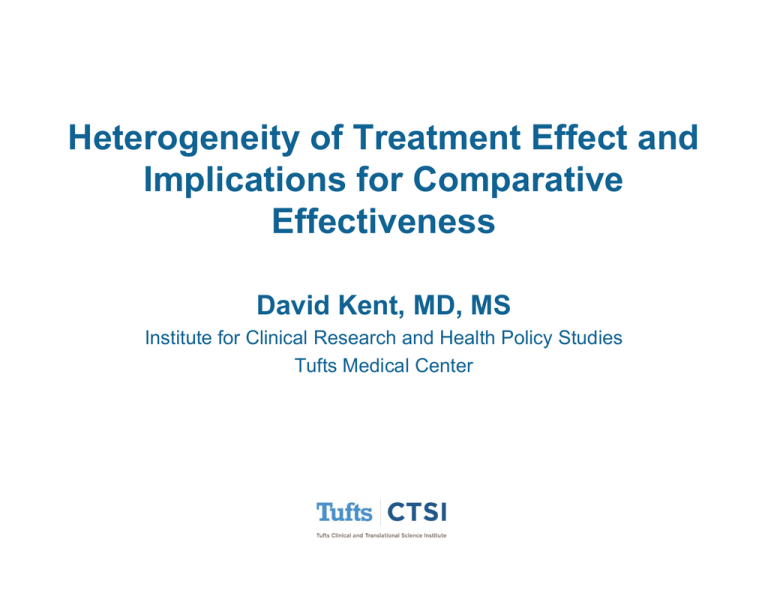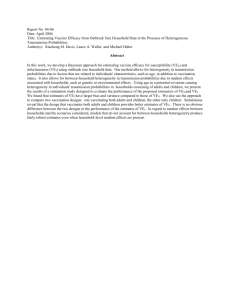Heterogeneity of Treatment Effect and Implications for Comparative Effectiveness David Kent, MD, MS
advertisement

Heterogeneity of Treatment Effect and Implications for Comparative Effectiveness David Kent, MD, MS Institute for Clinical Research and Health Policy Studies Tufts Medical Center Comparative Effectiveness Research • “The core question of comparative effectiveness research (is) which treatment works best, for whom, and under what circumstances.” CAPRIE Trial • Included 19,185 patients with atherosclerotic vascular disease manifested as either recent ischaemic stroke (IS), recent MI, or symptomatic peripheral arterial disease (PAD). • Randomised to: – clopidogrel (75mg once daily) – aspirin (325mg once daily) • Outcome: composite outcome cluster of ischaemic stroke, MI, or vascular death CAPRIE Steering Committee. Lancet 1996;348(9038):1329-1339. Results Hasford J, et al. J Clin Epimemiol 2010:63;1298-1304. CAPRIE Steering Committee. Lancet 1996;348(9038):1329-1339. For Whom Should Clopidogrel Use Be Approved/Recommended/Funded? • Approve for patients with: – Either recent IS, recent MI, or symptomatic PAD. – Recent IS or symptomatic PAD, but not recent MI – PAD only – None of the above. NICE vs IQWiG • National Institute for Health and Clinical Excellence (NICE) UK – Benefit for all – However not cost-effective • Institute for Quality and Efficiency in Health Care (IQWiG) Germany – Acknowledged superiority only in subgroup with PAD – Performed no CEA (by law) Subgroup analyses that have shown clinically important heterogeneity of treatment effect, which has subsequently shown to be false Rothwell PM. Lancet 2005;365(9454):176-86. • Subgroup analysis of clinical trials can be misleading. • Subgroup analysis of clinical trials can be misleading. • Overall (summary) results of clinical trials can be misleading. • Average results of clinical trials do not apply to all patients in the trial. • Even in trials with well-defined inclusion/exclusion criteria, there is often extreme variation in outcome-risk and (therefore) treatment-benefit. • Aggregating results across heterogenous patients can lead to distortions or misperceptions of the treatment effect. • Even “typical” patients included in the trial may not be likely to get the average benefits in the summary results. • Conventional (“one-variable-at-a-time”) subgroup analyses will be inadequate to detect differences in treatment-effect across different patient groups. • Risk models, which look at multiple variables simultaneously, can be applied to clinical trials to disaggregate subjects into subgroups likely to have clinically meaningful differences in their treatment effect. Outcome Risk with Treatment 35% 30% 25% 20% 15% 10% 5% 0% 0% 5% 10% 15% 20% Outcome Risk Placebo Treatment without Harm Treatment with Harm 25% 30% Outcome Risk with Treatment 35% 30% Median “typical” patient 25% 20% Average (overall) result 15% 10% 5% 0% 0% 5% 10% 15% 20% Outcome Risk Placebo Treatment without Harm Treatment with Harm 25% 30% 25% Relative Risk Reduction 20% 15% 10% 5% 0% -5% -10% -15% -20% 0% 5% 10% 15% Outcome Risk Relative Risk Reduction 20% 25% 30% 25% Relative Risk Reduction 20% 15% 10% 5% 0% -5% “one-variable-at-time” subgroup analysis -10% -15% -20% 0% 5% 10% 15% Outcome Risk Relative Risk Reduction 20% 25% 30% 25% Relative Risk Reduction 20% 15% 10% 5% 0% -5% “one-variable-at-time” subgroup analysis Multivariate risk-based analysis -10% -15% -20% 0% 5% 10% 15% Outcome Risk Relative Risk Reduction 20% 25% 30% Kent DM, et al. J Gen Intern Med 2002; 17:887-94. Kent DM, et al. J Gen Intern Med 2002; 17:887-94. 16.3% 1.0% Kent DM, et al. J Gen Intern Med 2002; 17:887-94. DANAMI-2 Thune JJ, et al. Circulation 2005,112:2017-2021. DANAMI-2 Thune JJ, et al. Circulation 2005,112:2017-2021. Clinical Conditions where Outcome Risk is Major Determinant Clinical Condition Treatment Symptomatic carotid stenosis Carotid endarterectomy17 Non-valvular atrial fibrillation Anticoagulation for primary prevention of stroke44 Coronary artery disease Coronary artery bypass grafting45 Primary prevention of coronary artery disease Blood pressure lowering46 Aspirin47 Lipid lowering48 Acute coronary syndromes Early invasive strategy (versus conservative) Clopidogrel (versus placebo)49 Enaxparin (versus unfractionated heparin)50, 51 ST-Elevation acute myocardial infarction tPA (versus streptokinase)12, 52 Percutaneous coronary intervention (versus thrombolytic therapy)53, 54 Severe sepsis Drotrecogin alfa (activated protein C)55 Kent DM, et al. Trials 2010;11:85. Interim Summary • Heterogeneity of outcome risk is ubiquitous (other examples) Interim Summary • Heterogeneity of outcome risk is ubiquitous (other examples) • Heterogeneity of outcome risk gives rise to heterogeneity of treatment effect. Interim Summary • Heterogeneity of outcome risk is ubiquitous (other examples) • Heterogeneity of outcome risk gives rise to heterogeneity of treatment effect. • If there is any treatment-related harm, there will be both relative and absolute treatment effect heterogeneity. Interim Summary • Heterogeneity of outcome risk is ubiquitous (other examples) • Heterogeneity of outcome risk gives rise to heterogeneity of treatment effect. • If there is any treatment-related harm, there will be both relative and absolute treatment effect heterogeneity. • One variable at a time subgroup analyses are inadequate (and prone to spurious false positive results). Interim Summary • Heterogeneity of outcome risk is ubiquitous (other examples) • Heterogeneity of outcome risk gives rise to heterogeneity of treatment effect. • If there is any treatment-related harm, there will be both relative and absolute treatment effect heterogeneity. • One variable at a time subgroup analyses are inadequate (and prone to spurious false positive results). • Risk-based analyses will usually be adequately powered. Checklist for Reporting on Subgroup Analyses and Heterogeneity in Treatment Effects 1. 2. 3. 4. 5. Evaluate and report on the distribution of risk in the overall study population and in the separate treatment arms of the study by using a risk prediction model or index. Primary subgroup analyses should include reporting how relative and absolute risk reduction varies in a risk-stratified analysis. Any additional primary subgroup analysis should be pre-specified and limited to patient attributes with strong a prior pathophysiological or empirical justification. Conduct and report on secondary (exploratory) subgroup analyses separate from primary subgroup comparisons. All analyses conducted must be reported and statistical testing of HTE should be done using appropriate methods (such as interaction terms) and avoiding over-interpretation. Kent DM, et al. Trials 2010;11:85. Dimensions of Risk Heterogeneity • • • • Outcome Risk Treatment-Related Harm Competing Risk / Attributable Fraction Treatment Responsiveness Thank you!

